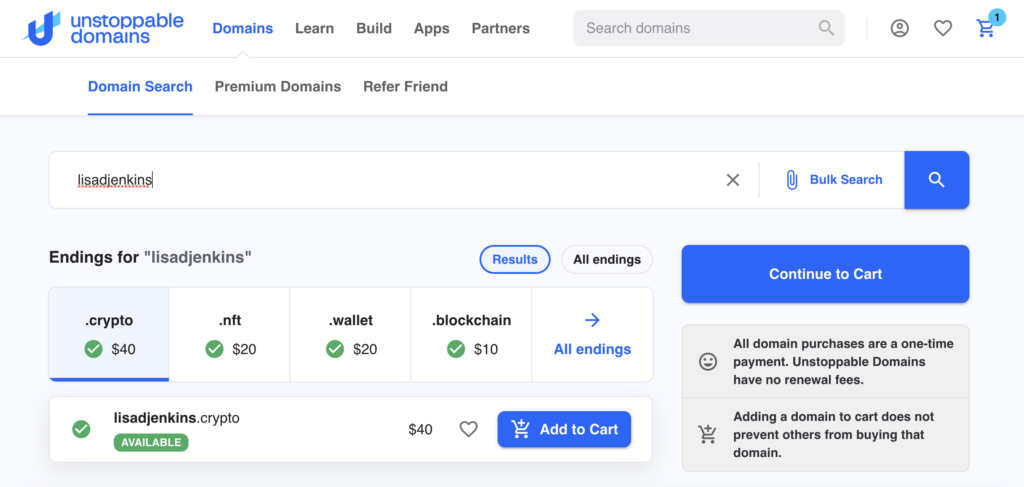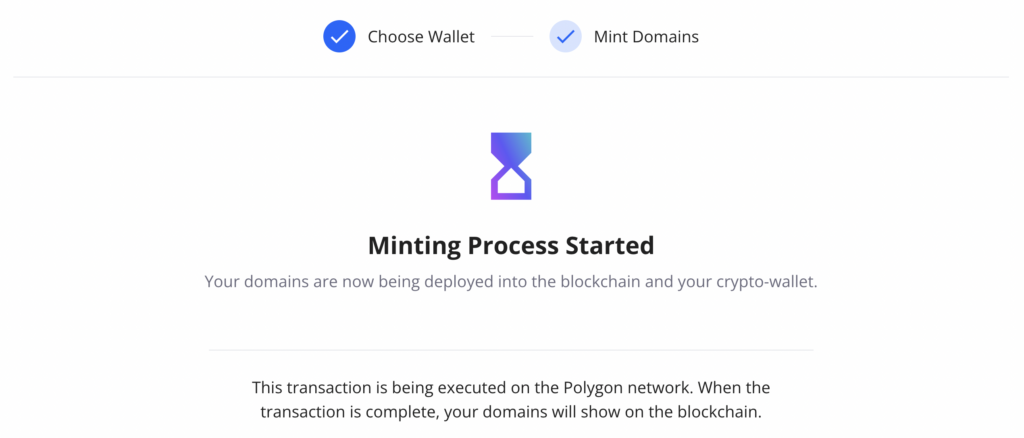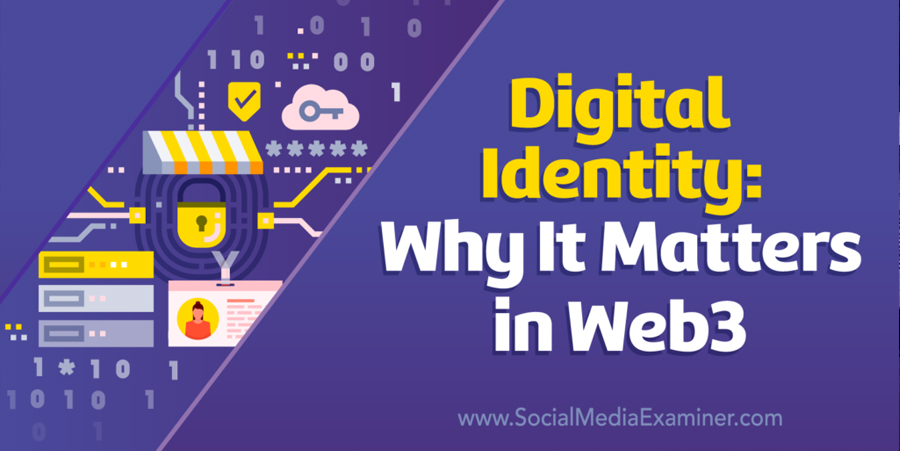Wondering how people will interact in a decentralized, transparent world? Do you imagine a future where your business will take advantage of the blockchain?
In this article, you’ll discover why digital identity matters for Web3 and you’ll learn how businesses are putting it to use.
This article was co-created by Sandy Carter and Michael Stelzner. For more about Sandy, scroll to Other Notes From This Episode at the end of this article.
How Web3 and Digital Identity Are Changing Business
Businesses of all sizes need to understand that Web3 is the next generation of the internet.
One of the exciting things about Web3 is that it will leverage blockchain, decentralization, and digital identity to improve the relationship between business and customer.
To understand how the relationship will improve, you need to understand how all four relevant pieces of the tech stack fit together. Think of it as a layer cake.
Layer 1: Blockchain
The foundational layer or backbone of the metaverse is blockchain technology. Blockchain is a trusted, secure, immutable, and programmable technology that’s used by many Web2 companies today.
Starbucks and Google, to name two.
To clarify, blockchain is not cryptocurrency; cryptocurrency is a use case of blockchain technology.
Layer 2: Web3
Sitting on top of blockchain technology is Web3. Web3 allows decentralization and shifts ownership of your personal data from third-party entities to you, the individual.
Layer 3: Decentralized Autonomous Organizations (DAOs)
A staple of Web3 and powered by blockchain, DAOs provide a new way for stakeholders to gather around and govern a project, business, or organization. A DAO allows each member of the community to exercise their individual voice and vote on initiatives.
Layer 4: Metaverse
The metaverse sits on top of all three layers and brings in artificial intelligence, augmented reality, and virtual reality to create a 3D internet.
The Full Tech Stack Puts Consumers in Charge
On one side of this cake or tech stack are the businesses and creators (artists, musicians, etc.) that produce goods. On the other side is the digital consumer network made up of everyone who consumes goods.
In traditional Web2 marketplaces, at least one third party such as Google or Meta is typically involved in one way or another. In fact, Google and Facebook make a hundred billion dollars annually by selling individual users’ data to retailers and other businesses that want to reach them via Facebook or Google ads. The retailers that purchase the data then have to factor in a percentage for fraudulent data.
In Web3 marketplaces, the need for businesses to buy third-party user data will be eliminated because individuals can decide for themselves which businesses can access their data. The blockchain will ensure that the data is accurate.
Marketers, in turn, will shift from using targeted data to reach consumer audiences to figuring out how to entice individual consumers to share their personal data with that business.
This brings us to digital identities.
What Is Digital Identity?
In Web2, a person’s identity varies. One identity is used to sign into Google, another is used to sign into Facebook, and so on. Even if each of these identities uses the same email address, they all require separate accounts using separate login credentials.
You as a user give each network access to your data in exchange for the convenience of using its platform. That platform then sells your data and owns your audience, in a sense.
Web3 flips that scenario on its head by allowing you to use a single identity that’s tied to your digital wallet.
Rather than setting up a separate account on every platform, Web3 allows people to connect their unique wallet to an application or platform. And with that connection, a person can decide exactly what data to share. No more subjecting yourself to hundreds of emails clogging your inbox simply because you made a purchase. You can decide whether to give a business access to your email address when you connect your wallet to their platform.
Use Cases for Digital Identity
Social Networks and Influence
A key pain point of Web2 is that as you move from application to application, your identity doesn’t follow you.
For example, in Web2, a person can sign into Twitter with several thousand followers and they hold influence on the platform thanks to those followers. Because the identity of that person stays with the application, when they create an account over on Discord or some other platform, they essentially create an entirely new identity with zero following on that application. The influence they hold as a brand stays with each individual network.
In Web3, this all changes because the influence you have on one platform goes with you when you sign up for another platform.
eCommerce and Privacy
Have you ever seen a t-shirt you wanted to buy from an online store but you held off because you didn’t want the multitudes of marketing emails you’d get for a year following your purchase?
In Web3, that store will have a permissions checklist and you can decide which of your personal details to share with that store.
Healthcare Decisions and Records
Today, about 60% of misdiagnoses happen because the doctor didn’t have access to the data they needed.
Web3 will also make the sharing of medical data during special circumstances such as moving to a new state, an emergency when the patient can’t discuss their medical history, or when a patient doesn’t know they need to divulge certain details because they misunderstand the relevance. Also, it won’t be necessary to request records to be sent to another healthcare facility, just to have those records get lost in transit. By having control over their own data, people can reduce the chances of that data being lost or incorrect due to human error.
Education
Your digital identity can go beyond just who you are and what you’re buying. Some universities are already testing the concept of including their diplomas, degrees, and certifications as NFTs, which would attach them to your digital identity. No more having to contact university personnel to find and send a copy of your transcripts whenever another organization asks for them. You can simply connect your wallet and grant that organization access to your university credentials.
Because these tokens sit on the blockchain, users and businesses alike can feel safe about their accuracy and security as validated, trusted data.
Digital tokens can also be used to validate a person’s attendance at a particular event. This opens up the possibility for businesses to offer new perks to people who attended events without the time-consuming task of going through records to verify attendance.
#3: How to Set Up a Digital Identity for Yourself or a Business
The first step in acquiring a digital identity is to choose and set up a crypto wallet such as MetaMask or Coinboise.
Then you need to secure that identity through a service like Unstoppable Domains.
Search for your preferred identity, then choose and purchase a domain to serve as your username/digital identity across Web3 applications.

Once you’ve purchased the domain you want to use as your digital identity, you mint that domain by connecting your wallet and documenting your ownership of that identity to the blockchain.

After the mint, it’s time to explore the possibilities of how you want to use this digital identity for your business.

You can give out NFTs for events or conferences you’re hosting, set up a seminar and give a small presentation in the Metaverse, etc.
—
This article first appeared in mail.google.com
Seeking to build and grow your brand using the force of consumer insight, strategic foresight, creative disruption and technology prowess? Talk to us at +971 50 6254340 or engage@groupisd.com or visit www.groupisd.com/story




